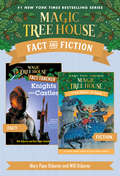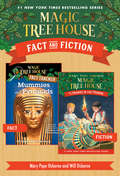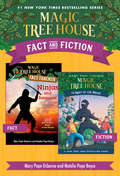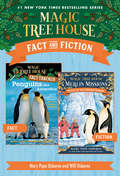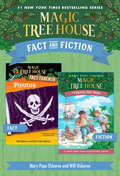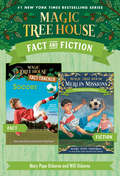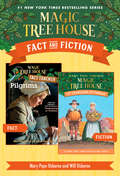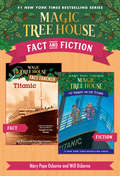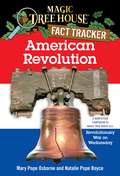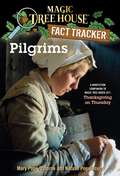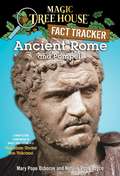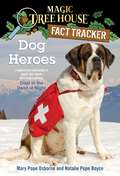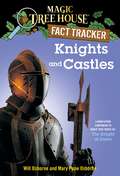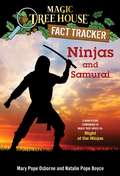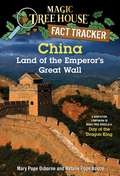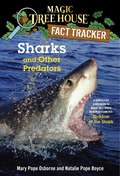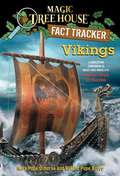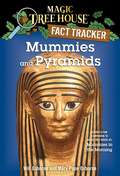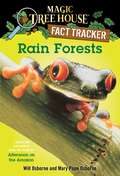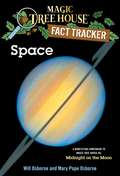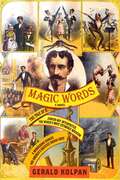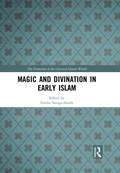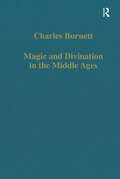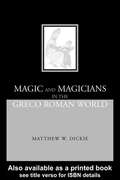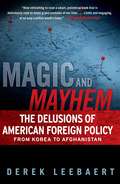- Table View
- List View
Magic Tree House Fact & Fiction: Knights (Magic Tree House (R))
by Mary Pope Osborne Sal Murdocca Natalie Pope BoyceRead the adventure and track the facts--it's two great ebooks in one! Join Jack and Annie as they travel to the Middle Ages in Magic Tree House® #2: The Knight at Dawn. Then uncover the facts behind the fiction in Magic Tree House® Fact Tracker: Knights and Castles. It's two favorite ebooks in one! Find out why Mary Pope Osborne's #1 New York Times bestselling series is such a hit with kids, parents, and teachers around the world.
Magic Tree House Fact & Fiction: Mummies (Magic Tree House (R))
by Mary Pope Osborne Will Osborne Sal MurdoccaRead the adventure and track the facts--it's two great ebooks in one! Join Jack and Annie as they travel to ancient Egypt in Magic Tree House® #3: Mummies in the Morning. Then uncover the facts behind the fiction in Magic Tree House® Fact Tracker: Mummies. It's two favorite ebooks in one! Find out why Mary Pope Osborne's #1 New York Times bestselling series is such a hit with kids, parents, and teachers around the world.
Magic Tree House Fact & Fiction: Ninjas (Magic Tree House (R))
by Mary Pope Osborne Will Osborne Sal MurdoccaRead the adventure and track the facts--it's two great ebooks in one! Join Jack and Annie as they travel to ancient Japan in Magic Tree House® #5: Night of the Ninjas. Then uncover the facts behind the fiction in Magic Tree House® Fact Tracker: Ninjas and Samurai. It's two favorite ebooks in one! Find out why Mary Pope Osborne's #1 New York Times bestselling series is such a hit with kids, parents, and teachers around the world.
Magic Tree House Fact & Fiction: Penguins (Magic Tree House (R))
by Mary Pope Osborne Sal Murdocca Natalie Pope BoyceRead the adventure and track the facts--it's two great ebooks in one! Join Jack and Annie as they travel to Antarctica in Magic Tree House® #40: Eve of the Emperor Penguin. Then uncover the facts behind the fiction in Magic Tree House® Fact Tracker: Penguins and Antarctica. It's two favorite ebooks in one! Find out why Mary Pope Osborne's #1 New York Times bestselling series is such a hit with kids, parents, and teachers around the world.
Magic Tree House Fact & Fiction: Pirates (Magic Tree House (R))
by Mary Pope Osborne Will Osborne Sal MurdoccaRead the adventure and track the facts--it's two great ebooks in one! Join Jack and Annie as they travel to the time of pirates and treasure maps in Magic Tree House® #4: Pirates Past Noon. Then uncover the facts behind the fiction in Magic Tree House® Fact Tracker: Pirates. It's two favorite ebooks in one! Find out why Mary Pope Osborne's #1 New York Times bestselling series is such a hit with kids, parents, and teachers around the world.
Magic Tree House Fact & Fiction: Soccer (Magic Tree House (R))
by Mary Pope Osborne Sal Murdocca Natalie Pope BoyceRead the adventure and track the facts--it's two great ebooks in one! Join Jack and Annie as they travel to Mexico City for the 1970 World Cup in Magic Tree House® #52: Soccer on Sunday. Then uncover the facts behind the fiction in Magic Tree House® Fact Tracker: Soccer. It's two favorite ebooks in one! Find out why Mary Pope Osborne's #1 New York Times bestselling series is such a hit with kids, parents, and teachers around the world.
Magic Tree House Fact & Fiction: Thanksgiving (Magic Tree House (R))
by Mary Pope Osborne Sal Murdocca Natalie Pope BoyceRead the adventure and track the facts--it's two great ebooks in one! Join Jack and Annie as they travel back to the first Thanksgiving in Magic Tree House® #27: Thanksgiving on Thursday. Then uncover the facts behind the fiction in Magic Tree House® Fact Tracker: Pilgrims. It's two favorite ebooks in one! Find out why Mary Pope Osborne's #1 New York Times bestselling series is such a hit with kids, parents, and teachers around the world.
Magic Tree House Fact & Fiction: Titanic (Magic Tree House (R))
by Mary Pope Osborne Sal Murdocca Natalie Pope BoyceRead the adventure and track the facts--it's two great ebooks in one! Join Jack and Annie as they travel to 1912 and on the maiden voyage of the Titanic in Magic Tree House® #17: Tonight on the Titanic. Then uncover the facts behind the fiction in Magic Tree House® Fact Tracker: Titanic. It's two favorite ebooks in one! Find out why Mary Pope Osborne's #1 New York Times bestselling series is such a hit with kids, parents, and teachers around the world.
Magic Tree House Fact Tracker #11: American Revolution (Magic Tree House (R) Fact Tracker #11)
by Mary Pope Osborne Sal Murdocca Natalie Pope BoyceMagic Tree House Research Guides are now Magic Tree House Fact Trackers! Track the facts with Jack and Annie! When Jack and Annie got back from their adventure in Magic Tree House #22: Revolutionary War on Wednesday, they had lots of questions. What was it like to live in colonial times? Why did the stamp Act make the colonists so angry? Who were the Minutemen? What happened at the Boston Tea Party? Find out the answers to these questions and more as Jack and Annie track the facts. Filled with up-to-date information, photos, illustrations, and fun tidbits from Jack and Annie, the Magic Tree House Fact Trackers are the perfect way for kids to find out more about the topics they discovered in their favorite Magic Tree House adventures.From the Trade Paperback edition.
Magic Tree House Fact Tracker #13: Pilgrims (Magic Tree House (R) Fact Tracker #13)
by Mary Pope Osborne Sal Murdocca Natalie Pope BoyceMagic Tree House Research Guides are now Magic Tree House Fact Trackers! Track the facts with Jack and Annie! When Jack and Annie got back from their adventure in Magic Tree House #27: Thanksgiving on Thursday, they had lots of questions. What was it like to sail on the Mayflower? Why did the Pilgrims choose Plymouth? How did they survive in their new home? What did they really eat at the first Thanksgiving? Find out the answers to these questions and more as Jack and Annie track the facts. Filled with up-to-date information, photos, illustrations, and fun tidbits from Jack and Annie, the Magic Tree House Fact Trackers are the perfect way for kids to find out more about the topics they discovered in their favorite Magic Tree House adventures.From the Trade Paperback edition.
Magic Tree House Fact Tracker #14: Ancient Rome and Pompeii
by Mary Pope Osborne Sal Murdocca Natalie Pope BoyceMagic Tree House Research Guides are now Magic Tree House Fact Trackers! Track the facts with Jack and Annie! When Jack and Annie got back from their adventure in Magic Tree House #13: Vacation Under the Volcano, they had lots of questions. How did ancient Rome become an emipre? Where did ancient Romans go for fun? What happened to the Roman town of Pompeii? What have we learned from it? Find out the answers to these questions and more as Jack and Annie track the facts. Filled with up-to-date information, photos, illustrations, and fun tidbits from Jack and Annie, the Magic Tree House Fact Trackers are the perfect way for kids to find out more about the topics they discovered in their favorite Magic Tree House adventures.From the Trade Paperback edition.
Magic Tree House Fact Tracker #24: Dog Heroes
by Mary Pope Osborne Sal Murdocca Natalie Pope BoyceMagic Tree House Research Guides are now Magic Tree House Fact Trackers! Track the facts with Jack and Annie!When Jack and Annie got back from their adventure in Magic Tree House #46: Dogs in the Dead of Night, they had lots of questions. How do St. Bernards help find avalanche survivors? Who are some of the most famous war dog heroes? What breeds make good service dogs? Find out the answers to these questions and more as Jack and Annie track the facts. Filled with up-to-date information, photos, illustrations, and fun tidbits from Jack and Annie, the Magic Tree House Fact Trackers are the perfect way for kids to find out more about the topics they discovered in their favorite Magic Tree House adventures.From the Trade Paperback edition.
Magic Tree House Fact Tracker #2: Knights and Castles (Magic Tree House (R) Fact Tracker #2)
by Mary Pope Osborne Will Osborne Sal MurdoccaMagic Tree House Research Guides are now Magic Tree House Fact Trackers! Track the facts with Jack and Annie!When Jack and Annie got back from their adventure in Magic Tree House #2: The Knight at Dawn, they had lots of questions. How were castles built? What was it like to live inside a castle? How did boys train to become knights? Did horses really wear armor? Find out the answers to these questions and more as Jack and Annie track the facts. Filled with up-to-date information, photos, illustrations, and fun tidbits from Jack and Annie, the Magic Tree House Fact Trackers are the perfect way for kids to find out more about the topics they discovered in their favorite Magic Tree House adventures.
Magic Tree House Fact Tracker #30: Ninjas and Samurai (Magic Tree House (R) Fact Tracker #30)
by Mary Pope Osborne Sal Murdocca Natalie Pope BoyceTrack the facts with Jack and Annie! When Jack and Annie came back from their adventure in Magic Tree House #5: Night of the Ninjas, they had lots of questions. What did it mean to be a ninja or a samurai? Did they really have special abilities? What was life like for them in ancient Japan? Find out the answers to these questions and more as Jack and Annie track the facts behind some of history's most intriguing and secretive figures. Filled with up-to-date information, photographs, illustrations, and fun tidbits from Jack and Annie, the Magic Tree House Fact Trackers are the perfect way for kids to find out more about the topics they discover in their favorite Magic Tree House adventures.
Magic Tree House Fact Tracker #31: Land of the Emperor's Great Wall
by Mary Pope Osborne Natalie Pope Boyce Carlo MolinariTrack the facts with Jack and Annie! When Jack and Annie came back from their adventure in Magic Tree House® #14: Day of the Dragon King, they had lots of questions. Who was the Dragon King? How did he build the Great Wall? What is Chinese New Year? What are some other Chinese traditions? Find out the answers to these questions and more as Jack and Annie track the facts about Chinese history and culture. Filled with up-to-date information, photographs, illustrations, and fun tidbits from Jack and Annie, the Magic Tree House Fact Trackers are the perfect way for kids to find out more about the topics they discover in their favorite Magic Tree House adventures. And teachers can use Fact Trackers alongside their Magic Tree House fiction companions to meet common core text pairing needs. Have more fun with Jack and Annie on the Magic Tree House® website at MagicTreeHouse.com!From the Trade Paperback edition.
Magic Tree House Fact Tracker #32: Sharks and Other Predators
by Mary Pope Osborne Natalie Pope Boyce Carlo MolinariTrack the facts with Jack and Annie! When Jack and Annie came back from their adventure in Magic Tree House #53: Shadow of the Shark, they had lots of questions. How many teeth do sharks have? What is their favorite food? What are some other top predators? How do they keep life in balance? Find out the answers to these questions and more as Jack and Annie track the facts about sharks and other predators. Filled with up-to-date information, photographs, illustrations, and fun tidbits from Jack and Annie, the nonfiction Magic Tree House Fact Trackers are the perfect way for kids to find out more about the topics they discover in their favorite Magic Tree House adventures. And teachers can use Fact Trackers alongside their Magic Tree House fiction companions to meet Common Core text-pairing needs. Have more fun with Jack and Annie on the Magic Tree House website at MagicTreeHouse.com!
Magic Tree House Fact Tracker #33: Vikings
by Mary Pope Osborne Natalie Pope Boyce Carlo MolinariThe bestselling nonfiction companions to the Magic Tree House books! When Jack and Annie came back from their adventure in Magic Tree House #15: Viking Ships at Sunrise, they had lots of questions. Why did Vikings go on raids? Did they really wear horned helmets? What were Viking ships like? Find out the answers to these questions and more as Jack and Annie track the facts about Vikings. Filled with up-to-date information, photographs, illustrations, and fun tidbits from Jack and Annie, the Magic Tree House Fact Trackers are the perfect way for kids to find out more about the topics they discover in their favorite Magic Tree House adventures. And teachers can use Fact Trackers alongside their Magic Tree House fiction companions to meet Common Core text pairing needs. Have more fun with Jack and Annie on the Magic Tree House® website at MagicTreeHouse.com!
Magic Tree House Fact Tracker #3: Mummies and Pyramids (Magic Tree House (R) Fact Tracker #3)
by Mary Pope Osborne Will Osborne Sal MurdoccaMagic Tree House Research Guides are now Magic Tree House Fact Trackers! Track the facts with Jack and Annie! When Jack and Annie got back from their adventure in Magic Tree House #3: Mummies in the Morning, they had lots of questions. Why did people make mummies? What was the mysterious writing on mummy cases? How did most ancient Egyptians spend their days? How were the pyramids built? Find out the answers to these questions and more as Jack and Annie track the facts. Filled with up-to-date information, photos, illustrations, and fun tidbits from Jack and Annie, the Magic Tree House Fact Trackers are the perfect way for kids to find out more about the topics they discovered in their favorite Magic Tree House adventures.
Magic Tree House Fact Tracker #5: Rain Forests
by Mary Pope Osborne Will Osborne Sal MurdoccaMagic Tree House Research Guides are now Magic Tree House Fact Trackers! Track the facts with Jack and Annie! When Jack and Annie got back from their adventure in Magic Tree House #5: Afternoon on the Amazon, they had lots of questions. How much rain falls in a rain forest? What is the world's heaviest insect? What the heck is a sausage tree? Why is it important to preserve the world's rain forests? Find out the answers to these questions and more as Jack and Annie track the facts. Filled with up-to-date information, photos, illustrations, and fun tidbits from Jack and Annie, the Magic Tree House Fact Trackers are the perfect way for kids to find out more about the topics they discovered in their favorite Magic Tree House adventures.From the Trade Paperback edition.
Magic Tree House Fact Tracker #6: Space (Magic Tree House (R) Fact Tracker #6)
by Mary Pope Osborne Will Osborne Sal MurdoccaMagic Tree House Research Guides are now Magic Tree House Fact Trackers! Track the facts with Jack and Annie! When Jack and Annie got back from their adventure in Magic Tree House #8: Midnight on the Moon, they had lots of questions. How did the universe begin? How long does it take to get to the moon? How hot is the sun? What does it feel like to be in space? Find out the answers to these questions and more as Jack and Annie track the facts. Filled with up-to-date information, photos, illustrations, and fun tidbits from Jack and Annie, the Magic Tree House Fact Trackers are the perfect way for kids to find out more about the topics they discovered in their favorite Magic Tree House adventures.From the Trade Paperback edition.
Magic Words
by Gerald KolpanIn a riveting novel of love and adventure, young Julius Meyer comes to the New World to find himself acting as translator for the famed Indian chief Standing Bear.Young Jewish immigrant Julius comes of age surrounded by the wild world of 1867 Nebraska. He befriends the mysterious Prophet John, who saves his life when the two are captured by the Ponca Indian tribe. Living as a slave, Julius meets the noble chief Standing Bear and his young daughter, Prairie Flower, with whom he falls in love. Becoming the tribe&’s interpreter—its &“speaker&”—his life seems safe and settled. But Julius has reckoned without the arrival of his older cousin, Alexander—who, as the Great Herrmann, is the most famous young magician in America. Nor does he suspect the ultimate consequences of Alex&’s affair with Lady-Jane Little Feather, a glamorous—and murderous—prostitute destined to become the most scandalous woman on two continents. Filled with adventure, humor, and colorful characters, Magic Words is a riveting adventure about the nature of prejudice, the horror of genocide, and a courageous young man who straddles two worlds to fight for love and freedom.
Magic and Divination in Early Islam (The Formation of the Classical Islamic World #42)
by Emilie Savage-SmithMagic and divination in early Islam encompassed a wide range of practices, including belief in jinn, warding off the evil eye, the production of amulets and other magical equipment, conjuring, wonder-working, dream interpretation, predicting the weather, casting lots, astrology, and physiognomy. The ten studies here are concerned with the pre-Islamic antecedents of such practices, and with the theory of magic in healing, the nature and use of amulets and their decipherment, the arts of astrometeorology and geomancy, the refutation of astrology, and the role of the astrologer in society. Some of the studies are highly illustrated, some long out of print, some revised or composed for this volume, and one translated into English for the first time. These fundamental investigations, together with the introductory bibliographic essay, are intended as a guide to the concepts, terminology, and basic scholarly literature of an important, but often overlooked, aspect of classical Islamic culture.
Magic and Divination in the Middle Ages: Texts and Techniques in the Islamic and Christian Worlds (Variorum Collected Studies)
by Charles BurnettAfter discussing the terminology of talismanic magic (or necromancy) and its position in divisions of science in the Middle Ages, this book traces the history of talismanic texts from the Classical period through the Arabic world to the Latin Middle Ages. The principal authorities are Hermes and Aristotle, and the search for the ’secret knowledge’ of these ancient sages is shown to have been a catalyst for the translating activity from Arabic into Latin in 12th-century Spain. The second half of the volume is devoted to examples of the kinds of divination prevalent in Arabic and Latin-reading societies: chiromancy, onomancy, scapulimancy, geomancy and fortune-telling. The book ends with advice on when to practice alchemy and a prophetic letter of supposed Arabic provenance, warning of the coming of the Mongols. Several editions of previously unedited texts are included, with translations.
Magic and Magicians in the Greco-Roman World
by Matthew W Dickie Matthew W. DickieThis study is the first to assemble the evidence for the existence of sorcerors in the ancient world; it also addresses the question of their identity and social origins. The resulting investigation takes us to the underside of Greek and Roman society, into a world of wandering holy men and women, conjurors and wonder-workers, and into the lives of prostitutes, procuresses, charioteers and theatrical performers.This fascinating reconstruction of the careers of witches and sorcerors allows us to see into previously inaccessible areas of Greco-Roman life. Compelling for both its detail and clarity, and with an extraordinarily revealing breadth of evidence employed, it will be an essential resource for anyone studying ancient magic.
Magic and Mayhem: The Delusions of American Foreign Policy From Korea to Afghanistan
by Derek LeebaertAFGHANISTAN AND IRAQ are the latest in a string of blunders that includes Vietnam and an unintended war with China from 1950 to ’53, those four fiascoes being just the worst moments in nearly a lifetime of false urgencies, intelligence failures, grandiose designs, and stereotyping of enemies and allies alike. America brought down the Soviet empire at the cold war’s most dangerous juncture, but even that victory was surrounded by myths, such as the conviction that we can easily shape the destinies of other people. Magic and Mayhem is a strikingly original, closely informed investigation of two generations of America’s avoidable failures. In a perfectly timed narrative, Derek Leebaert reveals the common threads in these serial letdowns and in the consequences that await. He demonstrates why the most enterprising and innovative nation in history keeps mishandling its gravest politico-military dealings abroad and why well-credentialed men and women, deemed brilliant when they arrive in Washington, consistently end up leading the country into folly. Misjudgments of this scale arise from a pattern of self-deception best described as "magical thinking." When we think magically, we conjure up beliefs that everyone wants to be like us, that America can accomplish anything out of sheer righteousness, and that our own wizardly policymakers will enable gigantic desires like "transforming the Middle East" to happen fast. Mantras of "stability" or "democracy" get substituted for reasoned reflection. Faith is placed in high-tech silver bullets, whether drones over Pakistan or helicopters in Vietnam. Leebaert exposes these magical notions by using new archival material, exclusive interviews, his own insider experiences, and portraits of the men and women who have succumbed: George Kennan, Henry Kissinger, Robert McNamara, Donald Rumsfeld, Dick Cheney, and Presidents Kennedy, Carter, and George W. Bush all appear differently in the light of magic, as do wise men from Harvard, Georgetown, Stanford, and think tanks such as RAND and Brookings, as well as influential players from the media and, occasionally, the military, including General David Petraeus as he personifies the nation’s latest forays into counterinsurgency. Magic and Mayhem offers vital insights as to how Americans imagine, confront, and even invite danger. Only by understanding the power of illusion can we break the spell, and then better apply America’s enduring strengths in a world that will long need them.
